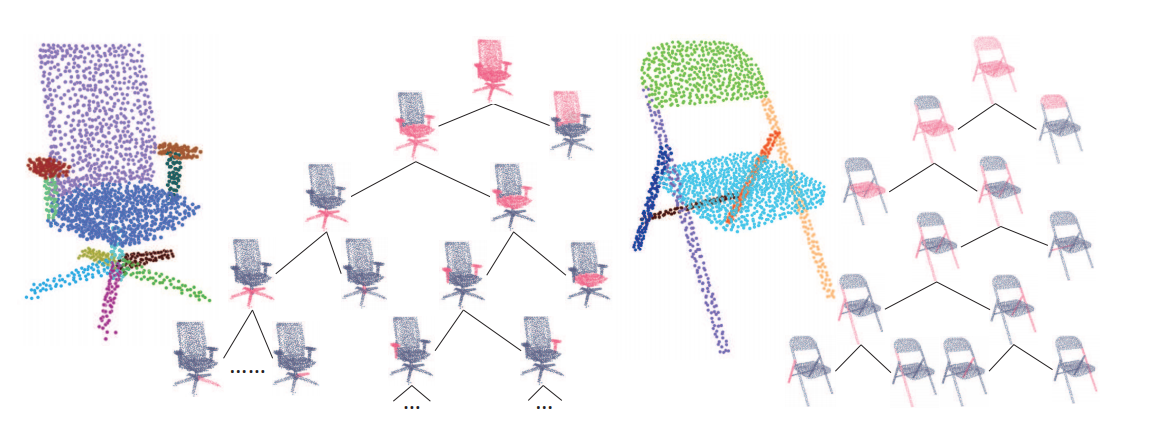PartNet: A Recursive Part Decomposition Network for Fine-grained and Hierarchical Shape Segmentation
Fenggen Yu#, Kun Liu#, Yan Zhang, Chenyang Zhu, Kai Xu*
CVPR 2019

Abstract: Deep learning approaches to 3D shape segmentation are typically formulated as a multi-class labeling problem. Existing models are trained for a fixed set of labels, which greatly limits their flexibility and adaptivity. We opt for topdown recursive decomposition and develop the first deep learning model for hierarchical segmentation of 3D shapes, based on recursive neural networks. Starting from a full shape represented as a point cloud, our model performs recursive binary decomposition, where the decomposition network at all nodes in the hierarchy share weights. At each node, a node classifier is trained to determine the type (adjacency or symmetry) and stopping criteria of its decomposition. The features extracted in higher level nodes are recursively propagated to lower level ones. Thus, the meaningful decompositions in higher levels provide strong contextual cues constraining the segmentations in lower levels. Meanwhile, to increase the segmentation accuracy at each
node, we enhance the recursive contextual feature with the shape feature extracted for the corresponding part. Our method segments a 3D shape in point cloud into an unfixed number of parts, depending on the shape complexity, showing strong generality and flexibility. It achieves the stateof-the-art performance, both for fine-grained and semantic segmentation, on the public benchmark and a new benchmark of fine-grained segmentation proposed in this work. We also demonstrate its application for fine-grained part refinements in image-to-shape reconstruction.

 Although PartNet is designed for fine-grained segmentation, the recursive decomposition should work even better for semantic segmentation since the latter is usually a much coarser-level segmentation. Comparison of semantic segmentation on the ShapeNet part dataset (Metric is part-wise IoU (%)). For semantic segmentation, PartNet can be trained with a consistent hierarchy for all shapes in a category. The training is can be done with any hierarchy that is consistent across all training shapes. Therefore, we do not need an extra process for hierarchy construction. Taking any random hierarchy of one training shape as a “template”, we unify the hierarchies of all the other shapes based on the semantic part labels. Therefore, PartNet does not require an extra supervision of part hierarchy for training for semantic segmentation.
Although PartNet is designed for fine-grained segmentation, the recursive decomposition should work even better for semantic segmentation since the latter is usually a much coarser-level segmentation. Comparison of semantic segmentation on the ShapeNet part dataset (Metric is part-wise IoU (%)). For semantic segmentation, PartNet can be trained with a consistent hierarchy for all shapes in a category. The training is can be done with any hierarchy that is consistent across all training shapes. Therefore, we do not need an extra process for hierarchy construction. Taking any random hierarchy of one training shape as a “template”, we unify the hierarchies of all the other shapes based on the semantic part labels. Therefore, PartNet does not require an extra supervision of part hierarchy for training for semantic segmentation.
PAPER / CODE
Overview

The architecture of PartNet. At each node, there are three modules devised for context propagation, hierarchy construction and point cloud segmentation, respectively. Being a recursive network, these modules are shared by all node in the hierarchy.
Evaluation

PAPER / CODE
Citation
BibTeX format:
@inproceedings{yu2019partnet,
title = {PartNet: A Recursive Part Decomposition Network for Fine-grained and Hierarchical Shape Segmentation},
author = {Fenggen Yu and Kun Liu and Yan Zhang and Chenyang Zhu and Kai Xu},
booktitle = {CVPR},
pages = {to appear},
year = {2019}
}